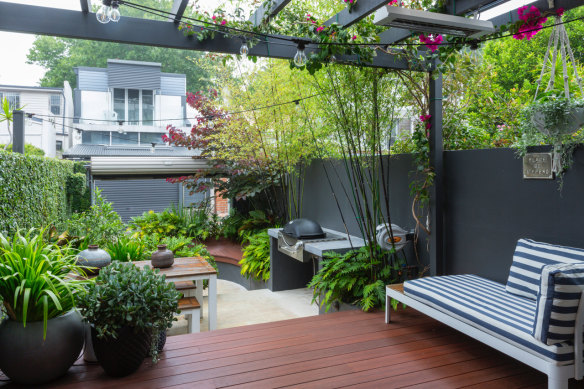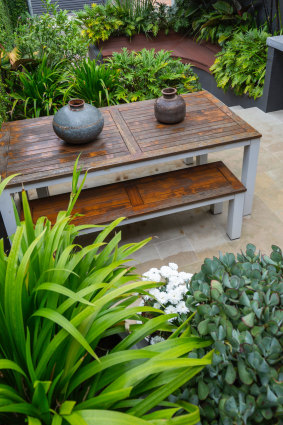
The acclaimed garden designer Fiona Brockoff has never set foot in my garden but she nails its biggest fault in her new book, With Nature (Hardie Grant, $70).
“Falling into the trap of too much variety happens frequently when designing planting schemes, especially in home garden situations,” she writes. “Plant temptation is everywhere… Setting tight parameters – and sticking to them – as well as accepting the process of natural attrition are useful brakes on confusion and excess in your garden.”
Composite timber deck, pergola and a small inner city courtyard garden.
Brockoff is our most influential designer of coastal gardens and her own garden, Karkalla, on the Mornington Peninsula, has inspired a whole new way of using – and pruning – Australian plants. In her book she reveals the decades-long process of work, experimentation and close attention to natural landscapes that underlies her approach, and shows 13 different gardens. Not all of these are coastal gardens, but they all do interesting things with a limited palette of plants to create sculptural places of quiet beauty.
Her book is atop my gift list this year, alongside Dream Gardens (Hardie Grant, $70). ‘The book of the tv series’ aren’t words that usually thrill, so host Michael McCoy was determined that Dream Gardens the book, would be more than a collection of stills and captions from the three series. Accordingly, alongside ample photographs of the 12 chosen gardens, McCoy contributes an introduction to each garden, a wide-ranging interview with its designer, and a short essay about a design concept embodied by each garden.
McCoy is a fine writer with an unquenchable appetite for thinking about what makes gardens work so the result offers plenty of visual inspiration, and much to consider. For example, Sydney-based Barbara Landsberg’s clever design for an inner-city terrace courtyard is a small space where nonetheless there are three distinct areas for sitting, dining, or lying, surrounded by plants.
An outdoor table and bench seat with decorative handmade metal pots.
These separate areas are achieved without screening, because as Landsberg tells McCoy, “We only pick up seven per cent of anything that we’re seeing or experiencing, and the rest is filled in by memory.”
“So that’s the magician’s trick – to know that you’re only actually at any one point dealing with one tiny amount of awareness and the rest is filled in. So you can make a suggestion of barrier or make a suggestion of enclosure and the mind will do a beautiful thing and take that hint and complete it.”
McCoy uses the courtyard garden to discuss ideas of usability, pointing out that you’ll more often enjoy a coffee or a drink in the garden than a meal; that it’s too hot to sit in full sun once the temperature reaches 21C, so shade is essential; and that accessibility, for your grandmother, your wheelbarrow, or your partner with a full tea tray, requires some forethought.
His conversations with the designers ensure the book explores a range of different ideas about gardens. Hugh Main puts in his bid for quiet gardens that reject visual stimulation in favour of a feeling of being grounded. Phillip Johnson talks up a new approach to native gardens in the suburbs.
Brockoff describes how the same group of no-water, no-feed plants can be used in different ways to give a garden a Japanese-style simplicity, with each plant in its own space, or a lush over-planted style with lots of texture and movement.
Both books are hours of pleasure for anyone interested in contemporary Australian gardens.
Make the most of your health, relationships, fitness and nutrition with our Live Well newsletter. Get it in your inbox every Monday.
Most Viewed in Lifestyle
From our partners
Source: Read Full Article

